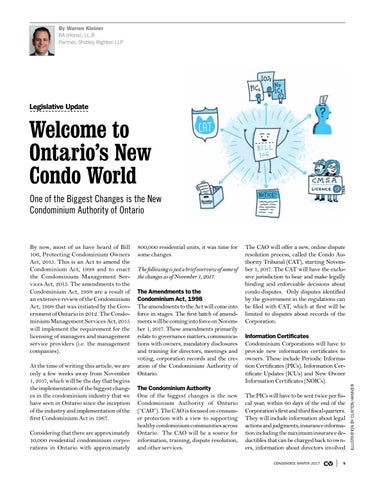By Warren Kleiner BA (Hons), LL.B Partner, Shibley Righton LLP
Legislative Update
Welcome to Ontario’s New Condo World One of the Biggest Changes is the New Condominium Authority of Ontario
At the time of writing this article, we are only a few weeks away from November 1, 2017, which will be the day that begins the implementation of the biggest changes in the condominium industry that we have seen in Ontario since the inception of the industry and implementation of the first Condominium Act in 1967. Considering that there are approximately 10,000 residential condominium corporations in Ontario with approximately
800,000 residential units, it was time for some changes. The following is just a brief overview of some of the changes as of November 1, 2017. The Amendments to the Condominium Act, 1998 The amendments to the Act will come into force in stages. The first batch of amendments will be coming into force on November 1, 2017. These amendments primarily relate to governance matters, communications with owners, mandatory disclosures and training for directors, meetings and voting, corporation records and the creation of the Condominium Authority of Ontario. The Condominium Authority One of the biggest changes is the new Condominium Authority of Ontario (“CAO”). The CAO is focused on consumer protection with a view to supporting healthy condominium communities across Ontario. The CAO will be a source for information, training, dispute resolution, and other services.
The CAO will offer a new, online dispute resolution process, called the Condo Authority Tribunal (CAT), starting November 1, 2017. The CAT will have the exclusive jurisdiction to hear and make legally binding and enforceable decisions about condo disputes. Only disputes identified by the government in the regulations can be filed with CAT, which at first will be limited to disputes about records of the Corporation. Information Certificates Condominium Corporations will have to provide new information certificates to owners. These include Periodic Information Certificates (PICs), Information Certificate Updates (ICUs) and New Owner Information Certificates (NOICs). The PICs will have to be sent twice per fiscal year, within 60 days of the end of the Corporation’s first and third fiscal quarters. They will include information about legal actions and judgments, insurance information including the maximum insurance deductibles that can be charged back to owners, information about directors involved CONDOVOICE WINTER 2017
CV
9
ILLUSTRATION BY CLAYTON HANMER
By now, most of us have heard of Bill 106, Protecting Condominium Owners Act, 2015. This is an Act to amend the Condominium Act, 1998 and to enact the Condominium Management Services Act, 2015. The amendments to the Condominium Act, 1998 are a result of an extensive review of the Condominium Act, 1998 that was initiated by the Government of Ontario in 2012. The Condominium Management Services Act, 2015 will implement the requirement for the licensing of managers and management service providers (i.e. the management companies).
